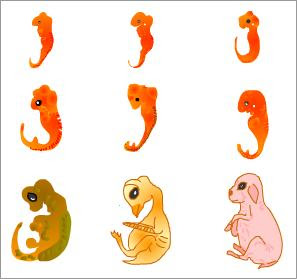
PART 2: Vestigial features
Definition: Rudimentary structures with no useful function
Okay so let's start off with the whale example. It has been proven that whales used to have legs or a similar species to whales that evolved into whales. So now whales and even snakes have hip and leg bones that come to no purpose
You can't really tell very well but the eye sockets here are actualy empty on this blind cave salamander suggesting that they have evolved from a species that have had eyes that were able to see.
PART 3: biochemistry
Biochemistry has alot to do with the genetic make up of cells. This could be the amino acid sequence in your skin cells and biochemistry is determining how the amino acid chain differs from other species over time that once had the same protein make-up. Scientists have started using this method in DNA. Scientists use the four bases in DNA- adenine, thymine, cytosine, and guanine- to compare different genetic make-ups in species to determine their similarities and differences. the pig and peccary have 7 similarities according to their DNA make-up, which can help up to determine their ancestores and different features that they have in common to also help us determine their ancestores and how they have changed according to their environment.
PART 4: Embryology
Definition: the branch of biology and medicine concered with the study of embryos and their development.
-Embryologists examine fertalization and track the development of the embryo.
-Study of sperm and eggs and the whole process of a little creature growing from a one celled organism to many.